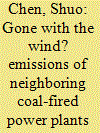| Srl | Item |
| 1 |
ID:
167009


|
|
|
|
|
| Summary/Abstract |
The Clean Air Act Amendments of 1990 (CAAAs) reduced criteria air pollution from coal-fired power plants (CFPPs) in the United States, but compliance strategies also altered the magnitude and phase of environmentally significant trace element emissions. The present work quantitatively assesses changes in trace element emissions stemming from CAAAs compliance, attributes these changes to specific CAAAs compliance strategies, and discusses implications for future environmental regulatory design. We combine plant-level coal purchase and installed air pollution control device data with a trace element partitioning model to approximate changes in trace element mass entering and exiting CFPPs in the solid, liquid, and gas phase between 1993 and 2017. Though US coal combustion decreased by 2% during this period, the vast majority of trace element emissions reductions stem from the 18-64% reductions in the fleet-wide average concentrations of arsenic, bromine, chloride, lead, mercury, and selenium in the combusted coal. Combined with the installation of air pollution control technologies, these shifts resulted in nationwide reductions of gas phase trace element emissions by between 49 and 68% for the elements included in this study. In contrast, installation of flue gas desulfurization devices increased the mass of trace elements discharged in wastewater. This work reinforces the value of multi-phase emissions regulations in ensuring that contaminants are not shunted from regulated to unregulated phases.
|
|
|
|
|
|
|
|
|
|
|
|
|
|
|
|
| 2 |
ID:
182781


|
|
|
|
|
| Summary/Abstract |
Based on a nationwide representative county-level dataset from China, this article empirically examines the spillover effects of air pollution from neighboring coal-fired power plants on local mortality rates due to cardiovascular and respiratory diseases. We combine data on power plants' industrial output with information on wind direction and speed to proxy for air pollution, and find that air pollution from neighboring power plants indeed has significant negative effects on local public health. The resulting treatment costs are also enormous. Our findings shed light on the necessity of intergovernmental cooperation in environmental governance.
|
|
|
|
|
|
|
|
|
|
|
|
|
|
|
|
| 3 |
ID:
150393


|
|
|
|
|
| Summary/Abstract |
A new international treaty, Minamata Convention, identifies mercury (Hg) as a global threat to human health and seeks to control its releases and emissions. Coal-fired power plants are a major source of mercury pollution worldwide and are expected to be the first key sector to be addressed in China under Minamata Convention. A best available technique (BAT) adoption model was developed in the form of a decision tree and cost-effectiveness for each technological option. Co-benefit control technologies and their enhancement with coal blending/switching and halogen injection (HI) can provide early measures to help China meet the Minamata Convention obligations. We project future energy and policy scenarios to simulate potential national mercury reduction goals for China and estimate costs of the control measures for each scenario. The “Minamata Medium” scenario, equivalent to the goal of the US Mercury and Air Toxics Standards (MATS) rule, requires the application of activated carbon injection (ACI) and HI on 30% and 20% of power plants, respectively. The corresponding total costs would be $2.5 billion, approximately one-fourth the costs in the US. An emission limit of 3 µg/m3 in 2030 was identified as a feasible policy option for China to comply with Minamata Convention.
|
|
|
|
|
|
|
|
|
|
|
|
|
|
|
|